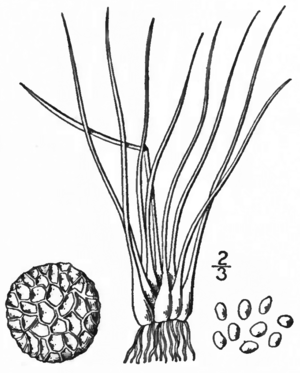Tuckerman's quillwort facts for kids
Quick facts for kids Tuckerman's quillwort |
|
|---|---|
 |
|
| Conservation status | |
| Scientific classification | |
| Genus: |
Isoetes
|
| Species: |
tuckermanii
|
| Synonyms | |
|
Calamaria tuckermanii (A.Braun ex Engelm.) Kuntze |
|
Isoetes tuckermanii, also known as Tuckerman's quillwort, is a special type of plant. It is a tetraploid species, which means its cells have four sets of chromosomes instead of the usual two. This plant belongs to the Isoetaceae family, which includes other plants called quillworts.
Contents
Where Tuckerman's Quillwort Lives
Tuckerman's quillwort likes to grow in shallow water. You can find it in parts of Canada, like Newfoundland, Nova Scotia, and New Brunswick. It also grows south through the New England states in the United States, all the way to Maryland.
What Tuckerman's Quillwort Looks Like
This plant has long leaves that are bright green to yellow-green. It usually has between 10 and 45 leaves. These leaves can be from 4 to 25 centimeters long. They usually stand straight up, but sometimes they might curve a bit.
Inside the Plant
Tuckerman's quillwort has a part called a sporangium, which is like a tiny spore case. It's usually about 5 millimeters long and 3 millimeters wide. A small flap called a velum covers about a quarter or less of this sporangium.
Spores
This plant produces two types of spores:
- Megaspores: These are larger, white, and shaped like tiny balls. They are about 400 to 650 micrometers across. If you look closely, they have rough, raised patterns that look like a honeycomb with six sides.
- Microspores: These are much smaller and shaped like a kidney bean. They are about 24 to 33 micrometers long and have small bumps called tubercles on them.
How to Tell it Apart
Tuckerman's quillwort looks very much like another plant called I. macrospora. It can be hard to tell them apart just by looking. Scientists usually need to study their cells (this is called cytology) or carefully measure their megaspores to know for sure which plant it is.


